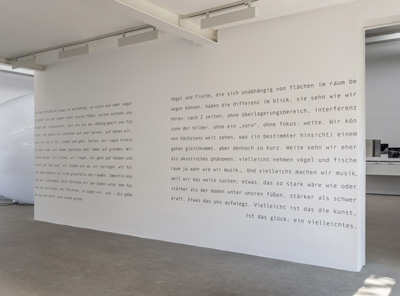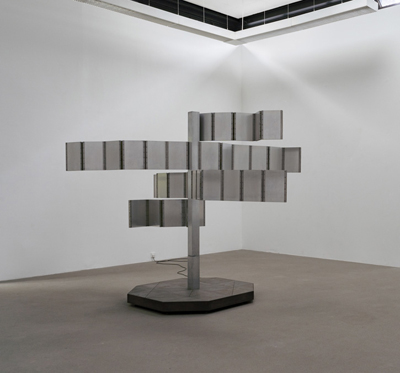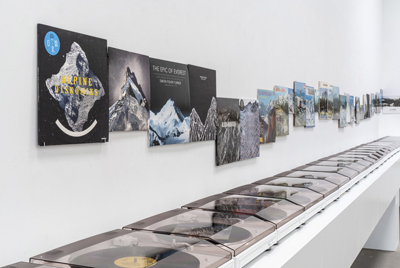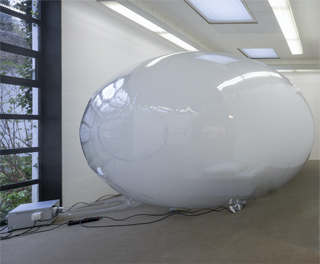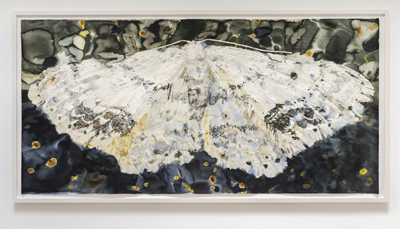Exhibition information
Borderlines of Space
May 14th - September 15th 2021
Lena von Goedeke, Franka Hörnschemeyer, Barbara Köhler, Melanie Manchot, Tanya Poole
Borderlines of Space brings together significant works by five female artists from the fields of sculpture, painting and poetry, realised as space and sound installations for Galerie m.
The poet and artist Barbara Köhler developed a text installation based on her poem Elf 1/2. The physical spatial experiences and existential questions described in it touch us directly. The title of the exhibition is borrowed from her poem.
Barbara Köhler, Elf ½
Barbara Köhler conceived her text installation especially for the exhibition Borderlines of Space. Her poem Elf ½, written back in 2008, describes borderline experiences and how humans attempt to find their own place in space. We are governed by the laws of gravity; we stand on solid ground and are always bound by spatial limitations. Figures of speech such as “losing the ground beneath one’s feet” ascribe existential significance to this relationship.
As an antithesis to such delimitation, Köhler muses on our search for expansiveness and how we grasp the space around us with our senses. This sensory experience is taken up by casting the text as a wall installation. The work extends across the full length of the wall, abrupt line breaks leaving word fragments dangling at the edges, evoking the tension that lets the poem burst out of its strict framework. The words become dynamic objects in their own right, whose interaction with the spatial conditions, the respective lighting situation, and the incidence and intensity of light renders their appearance unstable. In its monumentality, the written word is not only read as part of a text but is experienced as an independent visual entity. The building blocks of the text obtrude on our view, engaging in relationships with the surrounding artworks. Writing becomes a space of experience.
Franka Hörnschemeyer, Oszilloskop
Just like in Barbara Köhler’s lyrical installation, spatial experiences are an essential aspect of the works of sculptor Franka Hörnschemeyer, which likewise reflect physical sensations and existential moments.
Seemingly driven by an external force, the sculpture Oszilloskop explores its spatial possibilities through apparently arbitrary movements. Rising from a heavy geometric base, a narrow, angular column is equipped with six wings that project into the room at different heights. Each wing consists of five or six aluminum composite panels with a honeycomb structure that are connected by hinges and can thus move independently. Irregular mechanical impulses originating from the central axis set the multi-sectioned wings in motion, making the whole structure undulate in a flowing movement that feels almost organic. The Oszilloskop reaches far out into the surrounding space, spinning by turns slowly and leisurely or with breakneck speed and then returning again to a closed form, hugging itself. Associations with choreography come to mind, the musical accompaniment consisting here of the alternately loud or soft clacking and creaking of the individual segments, which repeatedly come up on limitations and are then forced to change direction.
In his essay “On the Marionette Theater” (1810), Heinrich von Kleist vividly describes how movement always has a center of gravity, so that a marionette is governed from within. The Oskilloskop, too, is brought to life by a central power source. This has the effect of shifting in our perception the borderline between controlled and intuitive-seeming movement, as the wings dance rhythmically as if by their own volition.
Melanie Manchot, Alpine Diskomiks
While Hörnschemeyer focuses on the interaction between body and space and their observation, the multimedia artist Melanie Manchot has created an audiovisual experience in her 21-meter-long installation Alpine Diskomiks that pushes the limits of our perception to extremes. Manchot has lined up here 50 turntables that are set spinning one after the other. At first, a record with an atmospheric mix of electronic sounds and drums is played. It forms the baseline and, with its running time of 19 minutes, defines both the beginning and end of the sound installation. Bit by bit, the other turntables join in, their music superimposed on the tracks already playing. The genres range from classical music by Franz Schubert to 70s pop and rock, from experimental electro sounds and folk music to death metal. What these vinyl records all have in common is the mountain motifs that adorn their covers, revealing the source of inspiration for the diverse musicians.
The successive overlapping of the varied music makes focusing and orientation increasingly difficult. The audio work culminates in a deafening cacophony, an intense and overwhelming soundscape that has the effect of melding the individual pieces of music together and literally making the listener dizzy. Manchot’s work turns the commonplace motif of the idyllic, romantic mountain landscape on its head, shifting the focus to the tremendous natural forces that have shaped these formations over millions of years.
Having reached the acoustic peak, the individual sound tracks gradually subside again and only the original music is heard; our sense of orientation gradually returns and we feel that we are back on solid ground. Acoustically evoked in this fashion, the mountain motif finds a harmonic visual counterpoint in the frieze of record covers on the walls above the turntables. Offset along the horizon line, the 50 covers form a long and colorful mountain range, beginning with the titular Alpine Diskomiks.
Lena von Goedeke, The Oneironaut (lab)
The air bubble in Lena von Goedeke’s room installation The Oneironaut (lab) seems to float between the walls of the exhibition gallery. The monumental elliptical sphere nearly fills the room. Machines and cables outside the bubble give us a vague impression of the complexity of the sphere but also hint at a functional connection between inside and outside and at the titular laboratory situation. The airspace inside the bubble is only dimly discernible through the more or less dense fog wafting through it. This fog eventually settles as a white veil on the inner surface, so that the sphere’s initially transparent skin gradually becomes more opaque, indelibly fixing the impression of fog in the material of the airspace.
The artist found inspiration for her work on one of her trips to the Norwegian archipelago of Svalbard. When riding a snowmobile through the so-called whiteout there, spatial boundaries and visual cues become blurred. Only with extreme concentration and adequate technical support can the visitor maintain orientation and control. The steady rhythm of one’s own breathing is the only reference for time and distance, and yet it poses a threat as condensation fogs up the helmet, completely blurring the view even of what is close-by.
The word Oneironaut is composed of the Greek words for dream and sailor, and might be translated as “dream walker.” With her spatial installation, von Goedeke builds a bridge between these two borderline experiences. Such phenomena demand the greatest of effort to maintain one’s bearings. Despite its dormant state of suspension, the work succeeds at immediately and vividly conveying this feeling to the viewer.
Tanya Poole, Span
Following her expansive vibrating installation The Coming Swarm from 2018, which focused on bees and bumblebees, Tanya Poole again turns her attention to an insect with her monumental ink painting Span (150 x 300 cm). As the moth flaunts itself in all its glory, we suddenly view the humble insect in a completely new light. Poole displays once more here her command of the wash technique, which she uses to reveal forms and contexts that are otherwise hidden from the eye. As in other works, she plays with flowing transitions between abstract, seemingly random color gradients and precise anatomical rendering, creating a vibrant tension that lets us experience the essence of moth-ness with a clarity that no lifelike image can match.
Moths are inconspicuous creatures. They live amongst us, but we notice them only fleetingly. Poole manages to break down the barrier between our world and theirs. She imagines “their fertile nightly flights in moonless forests or dark fields, drawn to drifting scents and pale luminescence.” (Poole) The artist made a close study of her subjects, sketching the subtle variety in their wing scale patterns. “But as the moths’ visual complexity revealed itself to me, I knew that I needed to paint them much, much larger and that my small sketchbook observations wouldn’t describe this vast and previously unseen richness. I made two large-scale paintings on paper: Span (3 metres wide) and The Night Guide (2 metres wide). Ink needs space to live and the size of the large-scale paper allowed it to run, pool, dissolve and layer.”
The ink painting Span overcomes the conventional boundaries of our perception and hones our awareness for in-between areas and connections that often elude us.
Borderlines are today more topical than ever. Usually geographically or politically based, they are an urgent theme in both philosophical discourse and art, prompting us to question our way of life. The complex artistic positions in the exhibition Borderlines of Space suggest a variety of different ways of conceiving of this subject. They have the effect of shifting the borderlines within our own experience of space, thereby challenging our entrenched visual habits.
Lena von Goedeke, Franka Hörnschemeyer, Barbara Köhler, Melanie Manchot, Tanya Poole
Borderlines of Space brings together significant works by five female artists from the fields of sculpture, painting and poetry, realised as space and sound installations for Galerie m.
The poet and artist Barbara Köhler developed a text installation based on her poem Elf 1/2. The physical spatial experiences and existential questions described in it touch us directly. The title of the exhibition is borrowed from her poem.
Barbara Köhler, Elf ½
Barbara Köhler conceived her text installation especially for the exhibition Borderlines of Space. Her poem Elf ½, written back in 2008, describes borderline experiences and how humans attempt to find their own place in space. We are governed by the laws of gravity; we stand on solid ground and are always bound by spatial limitations. Figures of speech such as “losing the ground beneath one’s feet” ascribe existential significance to this relationship.
As an antithesis to such delimitation, Köhler muses on our search for expansiveness and how we grasp the space around us with our senses. This sensory experience is taken up by casting the text as a wall installation. The work extends across the full length of the wall, abrupt line breaks leaving word fragments dangling at the edges, evoking the tension that lets the poem burst out of its strict framework. The words become dynamic objects in their own right, whose interaction with the spatial conditions, the respective lighting situation, and the incidence and intensity of light renders their appearance unstable. In its monumentality, the written word is not only read as part of a text but is experienced as an independent visual entity. The building blocks of the text obtrude on our view, engaging in relationships with the surrounding artworks. Writing becomes a space of experience.
Franka Hörnschemeyer, Oszilloskop
Just like in Barbara Köhler’s lyrical installation, spatial experiences are an essential aspect of the works of sculptor Franka Hörnschemeyer, which likewise reflect physical sensations and existential moments.
Seemingly driven by an external force, the sculpture Oszilloskop explores its spatial possibilities through apparently arbitrary movements. Rising from a heavy geometric base, a narrow, angular column is equipped with six wings that project into the room at different heights. Each wing consists of five or six aluminum composite panels with a honeycomb structure that are connected by hinges and can thus move independently. Irregular mechanical impulses originating from the central axis set the multi-sectioned wings in motion, making the whole structure undulate in a flowing movement that feels almost organic. The Oszilloskop reaches far out into the surrounding space, spinning by turns slowly and leisurely or with breakneck speed and then returning again to a closed form, hugging itself. Associations with choreography come to mind, the musical accompaniment consisting here of the alternately loud or soft clacking and creaking of the individual segments, which repeatedly come up on limitations and are then forced to change direction.
In his essay “On the Marionette Theater” (1810), Heinrich von Kleist vividly describes how movement always has a center of gravity, so that a marionette is governed from within. The Oskilloskop, too, is brought to life by a central power source. This has the effect of shifting in our perception the borderline between controlled and intuitive-seeming movement, as the wings dance rhythmically as if by their own volition.
Melanie Manchot, Alpine Diskomiks
While Hörnschemeyer focuses on the interaction between body and space and their observation, the multimedia artist Melanie Manchot has created an audiovisual experience in her 21-meter-long installation Alpine Diskomiks that pushes the limits of our perception to extremes. Manchot has lined up here 50 turntables that are set spinning one after the other. At first, a record with an atmospheric mix of electronic sounds and drums is played. It forms the baseline and, with its running time of 19 minutes, defines both the beginning and end of the sound installation. Bit by bit, the other turntables join in, their music superimposed on the tracks already playing. The genres range from classical music by Franz Schubert to 70s pop and rock, from experimental electro sounds and folk music to death metal. What these vinyl records all have in common is the mountain motifs that adorn their covers, revealing the source of inspiration for the diverse musicians.
The successive overlapping of the varied music makes focusing and orientation increasingly difficult. The audio work culminates in a deafening cacophony, an intense and overwhelming soundscape that has the effect of melding the individual pieces of music together and literally making the listener dizzy. Manchot’s work turns the commonplace motif of the idyllic, romantic mountain landscape on its head, shifting the focus to the tremendous natural forces that have shaped these formations over millions of years.
Having reached the acoustic peak, the individual sound tracks gradually subside again and only the original music is heard; our sense of orientation gradually returns and we feel that we are back on solid ground. Acoustically evoked in this fashion, the mountain motif finds a harmonic visual counterpoint in the frieze of record covers on the walls above the turntables. Offset along the horizon line, the 50 covers form a long and colorful mountain range, beginning with the titular Alpine Diskomiks.
Lena von Goedeke, The Oneironaut (lab)
The air bubble in Lena von Goedeke’s room installation The Oneironaut (lab) seems to float between the walls of the exhibition gallery. The monumental elliptical sphere nearly fills the room. Machines and cables outside the bubble give us a vague impression of the complexity of the sphere but also hint at a functional connection between inside and outside and at the titular laboratory situation. The airspace inside the bubble is only dimly discernible through the more or less dense fog wafting through it. This fog eventually settles as a white veil on the inner surface, so that the sphere’s initially transparent skin gradually becomes more opaque, indelibly fixing the impression of fog in the material of the airspace.
The artist found inspiration for her work on one of her trips to the Norwegian archipelago of Svalbard. When riding a snowmobile through the so-called whiteout there, spatial boundaries and visual cues become blurred. Only with extreme concentration and adequate technical support can the visitor maintain orientation and control. The steady rhythm of one’s own breathing is the only reference for time and distance, and yet it poses a threat as condensation fogs up the helmet, completely blurring the view even of what is close-by.
The word Oneironaut is composed of the Greek words for dream and sailor, and might be translated as “dream walker.” With her spatial installation, von Goedeke builds a bridge between these two borderline experiences. Such phenomena demand the greatest of effort to maintain one’s bearings. Despite its dormant state of suspension, the work succeeds at immediately and vividly conveying this feeling to the viewer.
Tanya Poole, Span
Following her expansive vibrating installation The Coming Swarm from 2018, which focused on bees and bumblebees, Tanya Poole again turns her attention to an insect with her monumental ink painting Span (150 x 300 cm). As the moth flaunts itself in all its glory, we suddenly view the humble insect in a completely new light. Poole displays once more here her command of the wash technique, which she uses to reveal forms and contexts that are otherwise hidden from the eye. As in other works, she plays with flowing transitions between abstract, seemingly random color gradients and precise anatomical rendering, creating a vibrant tension that lets us experience the essence of moth-ness with a clarity that no lifelike image can match.
Moths are inconspicuous creatures. They live amongst us, but we notice them only fleetingly. Poole manages to break down the barrier between our world and theirs. She imagines “their fertile nightly flights in moonless forests or dark fields, drawn to drifting scents and pale luminescence.” (Poole) The artist made a close study of her subjects, sketching the subtle variety in their wing scale patterns. “But as the moths’ visual complexity revealed itself to me, I knew that I needed to paint them much, much larger and that my small sketchbook observations wouldn’t describe this vast and previously unseen richness. I made two large-scale paintings on paper: Span (3 metres wide) and The Night Guide (2 metres wide). Ink needs space to live and the size of the large-scale paper allowed it to run, pool, dissolve and layer.”
The ink painting Span overcomes the conventional boundaries of our perception and hones our awareness for in-between areas and connections that often elude us.
Borderlines are today more topical than ever. Usually geographically or politically based, they are an urgent theme in both philosophical discourse and art, prompting us to question our way of life. The complex artistic positions in the exhibition Borderlines of Space suggest a variety of different ways of conceiving of this subject. They have the effect of shifting the borderlines within our own experience of space, thereby challenging our entrenched visual habits.

